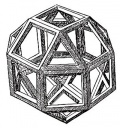Caladrius
From The Art and Popular Culture Encyclopedia
|
Related e |
|
Featured: |
The caladrius, according to Roman mythology, is a snow-white bird that lives in the king's house. It is said to be able to take the sickness into itself and then fly away, dispersing the sickness and healing both itself and the sick person. The caladrius legend formed part of medieval bestiary materials, which typically provided a Christian moralization for the animals they discussed.
Origin
It has been theorized that the caladrius is based on a real bird. Due to descriptions of it being completely white with no black on it, it is possible that it was based on the dove, or possibly some sort of water bird such as the heron. The art historian, Louis Réau, believed it was most likely a white plover.
In medieval bestiaries
Medieval interpretations focused on the diagnostic potential of the bird: if it looks into the face of a sick person, the person will live; if it looks away, the person will die. This is compatible with the idea that the caladrius' look draws the sickness into itself; the bird is then said to fly up to the sun, where the disease is burned up and destroyed. In the Christian moralization, the caladrius represents Christ, who is pure white without a trace of the blackness of sin. The bird shows how Christ turns away from unrepentant sinners and casts them off; but those to whom he turns his face, he makes whole again. Sometimes this moral is used specifically against the Jews to describe how, because the Jews did not believe, Christ turned his face from them and toward the Gentiles, taking away and carrying their sins to the cross.

